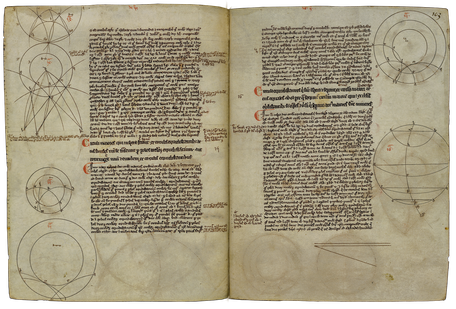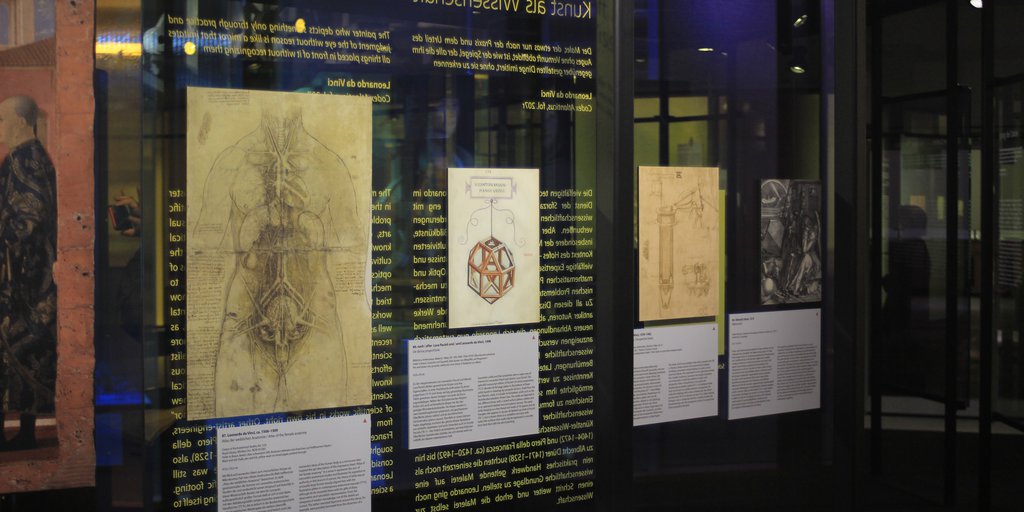
Science as Art, Art as Science <
The painter who depicts something only through practice and judgment of the eye without reason is like a mirror that imitates all things
placed in front of it without recognizing them
Leonardo da Vinci
Codex Atlanticus, fol. 207r. Translation: Elizabeth Hughes
The many and varied technical tasks Leonardo had to master in the service of the Sforzas were closely linked to scientific problems and challenges. But also the practice of the visual arts, especially painting, increasingly required theoretical knowledge and diverse expertise, particularly in the cultivated context of the court. This ranged from questions of optics and mathematical perspective construction to mechanical problems and medical knowledge. Leonardo now tried to learn systematically from the existing fundamental works by ancient authors related to all these disciplines, as well as from medieval sources and a growing number of more recent treatises. He expanded his library with specialist scientific literature and made concentrated and ambitious efforts to learn Latin and deepen his mathematical knowledge. This eventually enabled him to formulate new scientific insights of his own. He had now become an “author” of scientific works in his own right. Other artist-engineers, from Leon Battista Alberti (1404–1472) and Piero della Francesca (ca. 1420–1492) to Albrecht Dürer (1471–1528), also sought to place painting, which at the time was still considered a purely practical craft, on a scientific footing. Leonardo went one step further and elevated painting itself to a science.
Leonardo's Berlin Library: Section 8 <
- 70.
Tetragonismus
Edited by Luca Gaurico. Venice: Giovanni Battista Sessa, 1503
- 71.
Miscellanea
13th c.
- 72.
Prospectiva communis
Edited by Facius Cardanus. Milan: Petrus de Corneno, 1482
- 73.
Opere
1468–1492
- 74.
Summa de arithmetica, geometria, proportioni et proportionalita
Venice: Paganinus de Paganinis, 1494
- 75.
Divina proportione: Opera a tutti glingegni perspicaci e curiosi necessaria
Venice: Paganini de Paganinis, 1509
- 76.
Underweysung der Messung, mit dem Zirckel und Richtscheyt, in Linien, Ebenen unnd gantzen corporen
Nuremberg: Hieronymus Andreae, 1525
- 77.
Fasciculus medicinae. Similitudo complexionum & elementorum
Venice: Johannes and Gregorius de Gregoriis, 1500
 | 71.
Miscellanea 13th c. |

The 13 books of the Elements (Greek: Stoicheia) by Euclid (ca. 300 BCE) summarize the mathematical knowledge of the time in a systematic and exemplary way, dealing with surface and spatial geometry, arithmetic, number theory, and proportion theory. It was used as a textbook for over 2,000 years in countless copies, editions, and translations. This makes the Elements one of the most influential and durable works not only in science but also in world literature as a whole. In Europe in the Middle Ages, the Elements was used first of all in Latin translations from the Arabic, such as the manuscript shown here based on the 12th-century version by the Englishman Adelard of Bath. The text was printed for the first time in Venice in 1482 in a version from 1255 edited by Johannes Campanus (12 ■), and was used by Leonardo.
References
Bambach, Carmen C. 2019. Leonardo da Vinci Rediscovered. Vol. 2: The Maturing of a Genius 1485–1506. 4 vols. New Haven / London: Yale University Press, 32–34, 460–464.
Lee, Funsoo. 2019. In Leonardo’s Library. The World of a Renaissance Reader, edited by Paula Findlen. Stanford, CA: Stanford Libraries, 174,
no. 45.
Steck, Max. 1981. Bibliographia Euclideana. Die Geisteslinien der Traditionen in den Editionen der “Elemente” (ΣTOIXEIA) des Euklid (um 365–300). Handschriften – Inkunabeln – Frühdrucke (16. Jahrhundert). Textkritische Editionen des 17. Jahrhunderts. Editionen der “Opera minora” (16.–20. Jahrhunderts). Arbor scientiarum. C. 1. Hildesheim: Gerstenberg.








